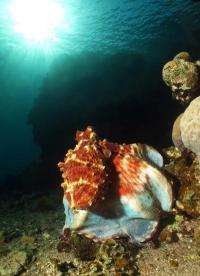Octopuses focus on key features for successful camouflage

Octopuses camouflage themselves by matching their body pattern to selected features of nearby objects, rather than trying to match the entire larger field of view, according to new research published in the open access journal PLoS ONE.
The animals have evolved sophisticated camouflaging abilities in response to intense predation pressure, but many of the details of this mechanism remain unknown.
Now, the researchers of the current study, led by Noam Josef of Ben-Gurion University in Israel, have used image analysis software to determine that this camouflage is based on a few key features of the environment, rather than the entire background visual field.
According to Josef, "by reproducing key features of well-chosen objects, the octopus can produce an effective camouflage that may fool a wide range of potential predators."
The authors speculate that this could make the strategy more flexible and increase success in slightly different environments.
More information: Josef N, Amodio P, Fiorito G, Shashar N (2012) Camouflaging in a Complex Environment—Octopuses Use Specific Features of Their Surroundings for Background Matching. PLoS ONE 7(5): e37579. doi:10.1371/journal.pone.0037579
Journal information: PLoS ONE
Provided by Public Library of Science


















